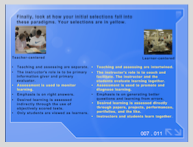learner-centered
Blogs as Assessments
22/Jan/2011 03:27 PM

I have to admit that prior to this week I did not see any real advantage to using a blog in a classroom, especially for assessment. If you read my previous post, you might get the feeling that that last sentence was quite contradictory to my constructivist views. It took a bit of persuading for me to see the advantages and power that a classroom blog can bring to student learning. I think the greatest benefit of using a blog is that students are able to build on their own knowledge and understanding. Then they can take it further through the interactions and clarifications with peers who can “speak” in the same language.
For many teachers, the mindset of the student in charge of his or her own learning can be difficult and threatening. Not for me though. I have always embraced it and now I’ve added another tool to my belt.
Comments
Teacher-Centered or Learner-Centered
19/Jan/2011 09:30 PM

One of the reforms it ushered in at my university was a “paradigm shift” in how science should be taught. The jargon that we used at the time was, “hands-on,” “experimental,” and “student exploration.” From that experience, I put those ideas into action in my own teaching. I soon realized how powerful the constructivist model of learning can be for students. I even structured student assessments to be learner-centered through lab practicals and products.
One area in the survey that didn’t match up was, “Assessment is used to monitor learning.” Monitoring student learning is absolutely critical to drive instruction. I also didn’t select, “Emphasis is on generating better questions and learning from errors.” While I tend to be more learner-centered with my assessments, they don’t always match up with the national drive for high-stakes tests that have become so prevalent.
